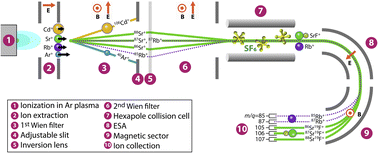In situ87Rb–87Sr analyses of terrestrial and extraterrestrial samples by LA-MC-ICP-MS/MS with double Wien filter and collision cell technologies†
Abstract
The advent of double-Wien filter-selection-aperture and hexapole-collision-cell technologies coupled to laser ablation multicollector inductively coupled plasma mass spectrometry (LA-MC-ICP-MS/MS) enables in situ analysis of 87Sr variations produced by the decay of radioactive 87Rb (t1/2 = 49.61 ± 0.16 Ga). We present methodologies to acquire in situ87Rb–87Sr data using a Thermo Scientific™ Neoma™ MC-ICP-MS coupled to a laser ablation system. The ions first pass through a mass filter that blocks ions outside of the Rb–Sr mass region. The ions then travel through a hexapole collision cell filled with SF6, inducing the fluorination of Sr+ to form SrF+. Strontium isotopes are measured as SrF+ free of interferences, while rubidium isotopes are measured as Rb+. Formulas are presented to calculate the error ellipses of 87Rb/86Sr and 87Sr/86Sr ratios corrected for instrumental fractionation by standard bracketing. While LA-MC-ICP-MS/MS is not as precise as Thermal Ionization Mass Spectrometry (TIMS), it is less destructive and sample throughput is higher. It is therefore particularly well suited to analyze small and precious samples, or to examine population characteristics. We have analyzed several terrestrial and extraterrestrial materials to showcase the unique capabilities of LA-MC-ICP-MS/MS in Sr isotopic analyses: (1) an orthoclase megacryst and other minerals from the 397 Ma Shap granite, (2) feldspar grains from the 26.5 ka Oruanui supereruption in New Zealand, (3) Durango apatite, (4) highly refractory hibonite inclusions from the Murchison meteorite, and (5) the martian meteorite NWA 7034 also known as Black Beauty. Black Beauty is a polymict breccia that contains zircons as old as 4.4 Ga but whose 40Ar/39Ar age was partially reset at 1.4 Ga. All K-feldspar grains analyzed in Black Beauty give an 87Rb–87Sr age of 2.189 ± 0.059 Ga. Most likely, the 2.2 Ga 87Rb–87Sr age represents the age of lithification. This study demonstrates the great potential of in situ87Rb–87Sr dating for analyzing samples returned by planetary exploration missions, such as those currently collected by the Perseverance rover on Mars, or those that will be returned from Phobos by the MMX mission.



 Please wait while we load your content...
Please wait while we load your content...